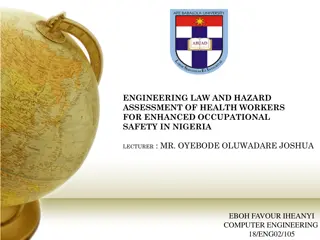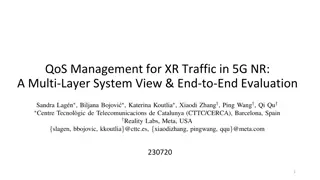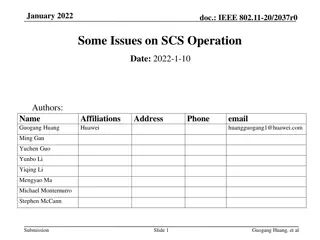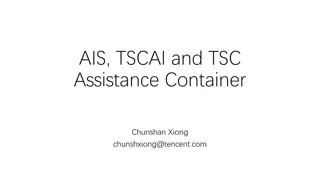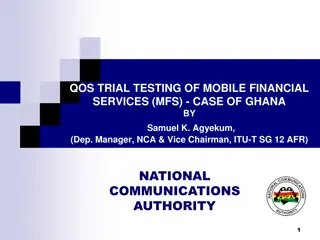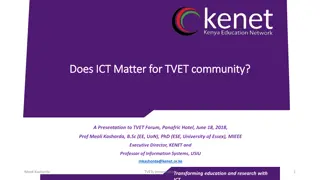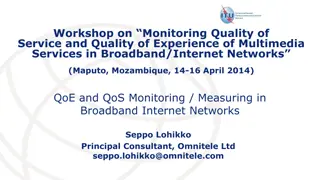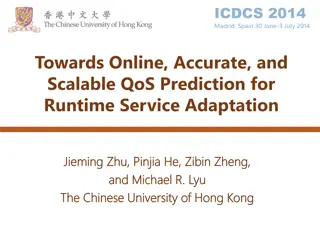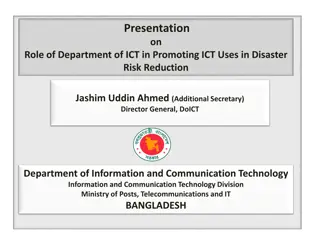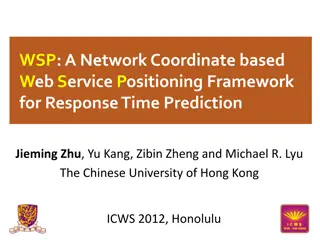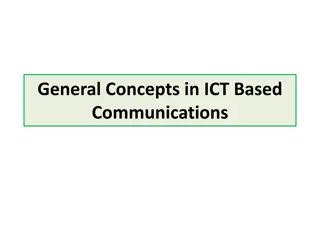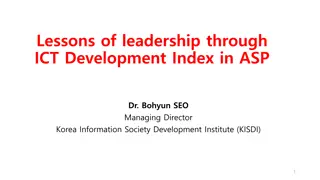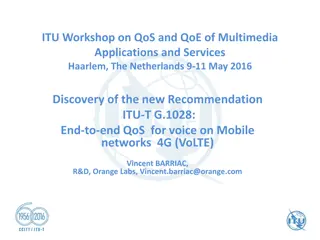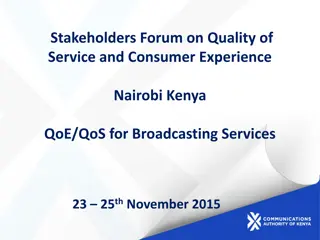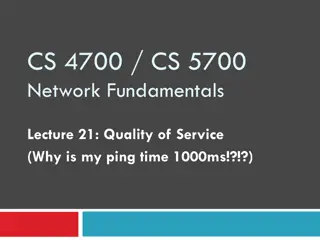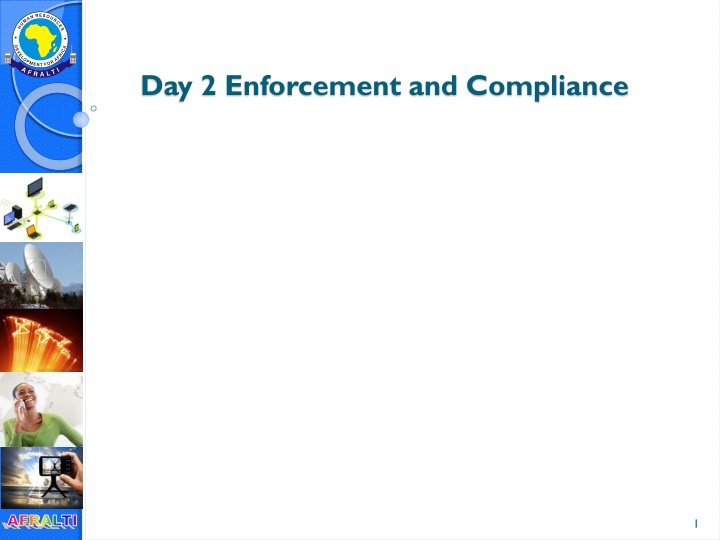
Regulatory Enforcement and Compliance for QoS in ICT Services
The regulatory enforcement and compliance for Quality of Service (QoS) in Information and Communication Technology (ICT) services is crucial for ensuring reliable and uninterrupted services for customers. Regulators play a key role in enforcing minimum QoS requirements to maintain service quality standards, transparent contract terms, and prevent degradation of service quality. Challenges such as the shift from legacy to IP networks and the need for end-to-end QoS in modern mobile and broadband services are addressed in regulatory guidelines and activities.
Download Presentation

Please find below an Image/Link to download the presentation.
The content on the website is provided AS IS for your information and personal use only. It may not be sold, licensed, or shared on other websites without obtaining consent from the author. If you encounter any issues during the download, it is possible that the publisher has removed the file from their server.
You are allowed to download the files provided on this website for personal or commercial use, subject to the condition that they are used lawfully. All files are the property of their respective owners.
The content on the website is provided AS IS for your information and personal use only. It may not be sold, licensed, or shared on other websites without obtaining consent from the author.
E N D
Presentation Transcript
Day 2 Enforcement and Compliance AFRALTI 1
REGULATORY ENFORCEMENT AND COMPLIANCE Vitalis Olunga ICT Strategy Consultant AFRALTI: 15th 17th March, 2017 AFRALTI
DAY 1 SESSION 3 REGULATORY TOOLS FOR QOS ENFORCEMENT General Regulatory Aspects of QoS Regulatory Options and Principles Activities in QoS Regulations Recommended QoS Regulations 1. 2. 3. 4. AFRALTI
Regulatory Aspects of QoS The objective of the regulatory guidelines: to assist regulators or administrations to achieve desired levels of QoS for ICT services under their jurisdiction Scope of the guidelines: end-to-end QoS as perceived by the user when using modern mobile and broadband services. correspondingly be used for traditional wire-bound and legacy services. AFRALTI 4
QoS Regulations A number of regulators enforce minimum QoSE requirements to ensure that customers and the providers have reliable and uninterrupted services, Network and service providers have to ensure transparent and clear terms and conditions of contracts signed by costumers. Regulators need to: ensure the publication of comparable information on the availability and QoSE and, Introduce minimum requirements for QoSE in order to avoid degradation of the quality provided to customers. AFRALTI 5
QoS Regulatory challenges Dramatic increase in mobile communication, Move from legacy to IP networks Standards Development Organizations Network Equipment Manufacturers: Network Operators and Service Providers Faced with mass market Acceptance of terminals in the market based on other factors rather than end-to-end QoS, such as price, other functions like MPG3 players, GPS, applications available like games, brand and artifacts e.g. "kids prefer the pink phone! Regulators and Administrators AFRALTI 6
Move from Legacy to IP Networks Makes pre-defined transmission planning of QoS a major challenge. Appropriate QoS standards may not be established or enforced. Modern packet-based network quality parameter requirements are much more undefined giving the impression that the responsibility for end-to-end QoS has been lost; IP networks cannot provide for self standing end-to-end QoS, but only transport classes, which enable QoS differentiation. AFRALTI 7
Standards development organizations (SODs) ITU-T , European Telecommunications Standards Institute (ETSI), Internet Engineering Task Force (IETF), have collective knowledge and expertise on QoS but face difficulty in harmonization of QoS Standards. The 3GPP is not SOD buy industry stakeholder's partnership Industry Stakeholders: mainly rely on industry standards instead of globally recognized standards, may keep control of their intellectual property may not invest resources in globally recognized standards, The SDOs may only try to convince industry leaders, for example, in dedicated events such as conferences. AFRALTI 8
Network Equipment Manufacturers: Rely on the QoS related performance requests from network operators and service providers. Participate in the QoS work of SDOs to standardize the QoS and performance requirements between several parties. The return of investment (RoI) from engagement in SDOs activities not readily visible. Terminal Device Manufacturers AFRALTI 9
Network operators and service providers Faced with the necessity of huge investments in both infrastructure and access technology. Likely to react partially by investing in new capacity, and partially by rationing existing capacity. Preference of traffic management tools for increasing the efficiency to manage existing network capacity rather than expansion. Use of traffic management as a method to suppress competition from the "un-managed" Internet (i.e., not differentiating between traffic types, source or destination points)-ISPs Their actions raise the Net Neutrality concerns AFRALTI 10
Network operators and service providers Inhibit content or application providers with which it competes from introducing new innovative products. May aim at providing services on top of the bit stream. Claim that "guaranteed QoS" (which is only a statistical guarantee) requires service differentiation in the networks; Prefers a traffic class differentiation, requesting a certain transport class from the network with different services. AFRALTI 11
Regulators/Administrations Challenges Responsibility to consumer protection being affected by the rapid introduction of vendor-specific services. Striking a balance between service competition and infrastructure competition to address the challenges associated with QoS on the networks. Assumption that the new technology provides QoS not less than in the ISDN era; Lose the overview of proprietary services provided by various NOs and SPs "on-net" and the QoSO. Services are not standardized, and interconnection scenarios need specific service agreements for each network-to-network-interface (NNI). AFRALTI 12
Regulators/Administrations Challenges The un-managed Internet has led to the creation of new services offered "over-the-top" (e.g., Skype), OTT is an important factor contributing to the economical benefits of countries; Services on the Internet can be created, improved, judged and used by each individual within the legal context without restrictions. AFRALTI 13
Regulators/Administrations Challenges The packed-based backbone of the NO providing proprietary services Information presented by NO and SP in a highly technical way which does not explain the 'real world' effects for consumers to act upon. Consumers may not be able to detect the actual applications of discriminating traffic management techniques NO carriage open to Internet traffic may give lower priority to the open Internet traffic due to inherent low revenue. The discrepancy between advertised and actual delivery speeds of the network. The need for clear and transparent communication of QoS parameters and network management practices AFRALTI 14
Regulators and Administration Consumers find it difficult to distinguish between the effects of traffic management techniques on QoS from the effects of other quality degrading factors. A consumer observing that traffic is routinely throttled may not know whether this is done by intention, or is caused by other factors such as network congestion, which is leading to the degradation of service. It is therefore important for the regulators and administrations to monitor the effectiveness of transparency and QoS. AFRALTI 15
Global Challenges Summary Service differentiation in modern packet based networks is facilitated with, e.g., the IP Multimedia Subsystem (IMS), which in its QoS part is basically a resource allocation tool. The exact services are not defined or standardized which makes IMS less flexible for services to be offered across multiple packet networks. IMS is under the sole control of the 3rd Generation Partnership Project (3GPP), 3GPP is not an SOD in the classical sense and its influence on the further development of IMS for ITU members is very limited. AFRALTI 16
Regulatory Technical Parameters Speed (data throughput) of the access network Congestion in the backbone End-to-end delay (latency) Delay-variation (jitter) Packet loss (loss of information). AFRALTI 17
Regulatory technical challenges The parameters have multiple facets depending on which kind of gateways are used to interconnect IP networks: Jitter is the variation in delay between different packets Jitter compensation (by de-jitter buffers) converts jitter into an additional delay which may build up and increase to unacceptable values Packet loss may be concealed to an extent where essential information is lost. Bad terminal implementations may destroy reasonable performance delivered from the network(s); Users not be able to judge the difference in end-to-end QoS. AFRALTI 18
Regulatory policy challenges Need to consider new approaches to anchor national strategies or regulatory frameworks around the multi-faceted concept of QoS, Set and keep the right balance between service and infrastructure competitions Address the challenges associated with QoS on the telecommunication network AFRALTI 19
Regulatory policy challenges Provision of adequate QoS by network operators and service providers that claim the need a certain traffic management over increasingly congested networks Data restrictions, traffic throttling, filtering and/or the use of data caps of thresholds Cases where by "Internet access" provided to customers is no longer Internet access, but a service provided by the ISP Implications of reduced speed Unsolicited services, e.g., entering wrong URLs Service restrictions AFRALTI 20
Regulatory Options and Principles AFRALTI 21
Selecting appropriate regulatory approach Alternative approaches Regulatory approach Customer oriented approach Market regulations AFRALTI 22
Alternative approaches: There are basically three alternative approaches: A regulation orientated approach; A customer orientated approach; A market oriented approach AFRALTI 23
Regulation orientated approach Reporting is to the regulator; Performance targets are set in regulations; Fines are payable to the regulator if targets are not achieved. In the early stages of market development, the regulation orientated approach may be appropriate. The performance may be poor but the focus is on achieving a basic minimum level of performance. AFRALTI 24
Regulation Oriented Approach, 2 Obtaining appropriate information on the level of QoS and identifying the problem areas: Publishing information on QoS performance for customers to be better informed; Imposing regulations on performance such as required minimum levels and fines or compensation; Undertaking a constructive dialogue with the operator concerned to encourage and foster improvements. AFRALTI 25
Customer orientated approach: Reporting is to the customer; Targets and minimum performance levels are given in contracts; Compensation for poor performance is payable to the affected customer. In a later stage of market development, the customer orientated approach may be preferable The regulator can reduce its involvement as the operator is pushed to have a closer relationship with the customer AFRALTI 26
Parameters to be Monitored by the Regulator Parameters to be monitored should relate to the aspect of services that have the biggest impact on users; Parameters should be well defined and be cost- effective to operators. The measurement methods already in use by operators should be used as far as possible. The parameters should reflect differences in, for example, services and geographic areas but should be consistent between services. AFRALTI 27
Cost Implications of Regulations QoS regulation has a cost that should be assessed against the benefits. Efforts should be focused where there are known problems, with some flexibility as problems change. The same requirements for measurement and reporting should not be applied to all possible parameters as this is needlessly expensive. One should "scratch where it itches, not everywhere". Highest effort levels should be focused on parameters that are both important to customers and where performance is poor or most at risk. AFRALTI 28
Legal System Requirements Legal system should allow regulations to include some scope for subsequent decisions Should allow determinations by the regulator without needing to go through the whole procedure for revising a regulation. The regulation could include a clause such as "The regulator may revise the list of parameters, target levels or reporting requirements in the future by giving 3 months written notice to the operators". AFRALTI 29
Principles for selecting parameters Parameters to should relate to the aspect of services that have the biggest impact on users; Parameters should be well defined and be cost- effective to operators. Parameters , as far as possible, should have methods of measurement that are already in use by the operators. Parameters should reflect differences in services and geographic areas but should be consistent between services. AFRALTI 30
Principles for selecting parameters Measurements to be published should relate to aspects of services that users experience directly (not the underlying technical cause). Publications should reach beneficiaries easily understood without being misleading. Publications should allow for comparison between operators. Targets set should relate to the quality users want. Targets should avoid limiting customer choices between quality and price. Values need to be determined through sufficient information such as earlier measurements by operators, used in other countries or proposed in international standards. AFRALTI 31
Activities in QoS Regulations AFRALTI 32
Activities in QoS regulation Activities in relation to quality of service regulation that emphasize the institutional and operational aspect of these activities: Defining parameters: Setting targets: Making measurements: Auditing measurements: Publishing measurements: Ensuring compliance: AFRALTI 33
Activities in QoS Regulations 'Should the fault repair time (FRT) be measured?' Consulting stakeholders 'The FRT is the average time taken to repair reported faults' Defining measurements 'The FRT should not be more than 1.5 days' Setting targets 'The FRT has been measured to be 1.375 days' Marking measurements Repeat every review period 'Has the fault repair time been measured accurately?' Auditing measurements Repeat every reporting period 'The FRT has been measured to be 1.4 days' Publishing measurements 'Encouragement and/or enforcement' Ensuring compliance Reviewing achievements 'Should FRT continue to be measured?' E.800-Suppl.9(13)_F02 AFRALTI 34
Defining Parameters When defining parameters, the involvement of operators is beneficial and desirable. It has to be noted that there is a risk that operators may exercise undue influence and that the consultation process can be lengthy. The regulator needs to exercise strong leadership while ensuring that stakeholders are consulted. AFRALTI 35
Defining Parameters The following factors, among others, should generally be taken into consideration: The practicability for operators to make the required measurements; The practicability for regulators or any independent entity to audit the results; The measurement being made should retain the customer experience aspect. AFRALTI 36
Setting parameter targets Targets are normally set by the regulator based on consultation and prior monitoring of an operator's data. The operators could also set their own targets and be obliged to publish their targets. Several aims that justify QoS regulation: some are more important when competition is strong, and others are more important when competition is weak. The aims are to help customer: make informed choices choosing a service and price, the best quality available at price chosen. AFRALTI 37
Justification of Parameters and targets Maintaining or improving quality in the presence or absence of competition Quality can be more important than price, especially for business customers, because problems with quality are more likely to be costly. To For services that are bundled together, with one price covering several services, the quality of specific aspects of the services can influence choices. Checking claims by operators: advertisements about their services or the services of their competitors., to ensure accurate claims. AFRALTI 38
Parameters and targets Understanding the state of the market and to to show how well policies are succeeding: Show gaps in performance that could be filled by market entry or by gaps that need new policies for particular groups of people, geographic areas or operating conditions (such as emergencies). Help to maintain quality in cases of price cutting that leads to cost cutting and reduction of quality. AFRALTI 39
Setting parameter targets Setting performance targets needs to be treated with care and the distinction between the minimum level of performance and the desired level needs to be maintained clearly. There is a risk that if there is a minimum QoS level specified in a market with little competition, as this will be regarded as an acceptable level. Better either not to set a target at all and just to report achieved performance levels, or to set two levels a minimum and a desired level. AFRALTI 40
Setting parameter targets Targets should relate to the quality users want. The targets to avoid limiting customer choices between quality and price. Target values to be determined through sufficient information such as: earlier measurements by operators, used in other countries Measurements recommended or proposed in international standards. AFRALTI 41
Making measurements The "customer interface" and "network infrastructure" parameters, measurements are conveniently made by operators, Many service functionality parameters are best made by external measurement agencies or by users to allow for comparison and reduce the cost of measurements. AFRALTI 42
Measurements of parameters Some variations of standard parameters may be necessary depending on the specific situation in a country or sector. The measurements of a parameter might need to distinguish between: Market segments: be different for private consumers, small and large businesses or for wholesale and retail offerings. Reporting areas: areas with likely differences in quality, such as rural and urban areas. AFRALTI 43
Measurements of parameters Operators: with few customers, that resell services from other operators or that are not dominant in the market might be exempted from monitoring parameters or publishing measurements. The variation could reduce inconvenience and costs. It is recommended that setting targets would be mainly necessary with dominant operators For other operators competition should help to reach the same results. AFRALTI 44
Measurements of parameters Parameters may be specific to services such as voice, text messages and Internet, television and radio broadcasting as well as leased lines as the main services that have most impact on users. The list may be too long and it may not always be desirable or necessary to impose quality of service regulation on all. Auditing measurements: signed off by senior employees in a "self-certification" process, audited by external agencies including independent auditors or checked by regulators themselves. Important considerations are costs (for both the regulator and the operator) and the effectiveness of audits. AFRALTI 45
Publishing measurements: Measurements should be published by the regulator to help with comparisons between operators. To simplify the task the number of measurements to be published could be reduced. Measurements to be published should relate to aspects of services that users experience directly (not the underlying technical cause). Publication of measurements needs: to ensure that they reach beneficiaries, that they are easily understood without being misleading should allow for comparison between operators. AFRALTI 46
Enforcing compliance: The regulator may start with recommendations and move towards obligations if the recommendations are important and practical, but the operator is not willing to take part. A range of techniques the regulator can adopt: "naming and shaming" strategies to tighter regulation, financial penalties and finally more drastic legal enforcements. As a general principle, it is recommended that encouragements and enforcements should be graduated and proportional. AFRALTI 47
Enforcement of QoS Regulations: Approaches AFRALTI 48
Recommended QoS Regulation Approaches AFRALTI 49
Recommended Regulation approach Information gathering and selection of parameters Information publication Target levels Penalties Constructive dialogue AFRALTI 50

